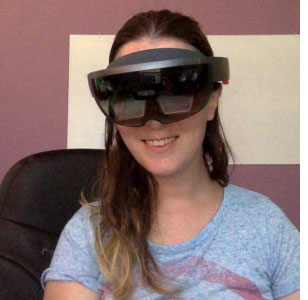Meet Medusa and Jenny—Drones You Fly with Your Mind

Founded in 2015, Astral AR creates immersive augmented reality, biometrics-piloted unmanned aerial vehicles that provide real-time 3-D feedback.
A growing drone startup uses augmented reality to drop the joystick.
Mind-controlled drones may sound like something out of a sci-fi movie, but thanks to the ingenuity of an Austin, Texas-based startup, they do in fact exist. Their not-so-small mission: Do good and save the world.
Astral AR was co-founded in 2015 by Leah LaSalla and Josè La Placa Amigò, and has since seen fast-growing interest in its immersive augmented reality, biometrics-piloted unmanned aerial vehicles that provide real-time 3-D feedback. The drones—all with female names like Medusa, Jenny and Clementine—can handle tasks too dangerous to humans; for example, search and rescue, firefighting, prospecting and mining, and even taking a bullet.
The company went from a working proof of concept to demo in six weeks, acquiring allies such as the Federal Emergency Management Agency and partners such as Microsoft, and then angel investor seed funding. Next, the team is headed to South by Southwest to showcase its drones and spread the word on their use for good.
» Get the best federal technology news and ideas delivered right to your inbox. Sign up here.
Nextgov’s Executive Editor Camille Tuutti caught up with Astral AR’s Technical Founder and CEO LaSalla and Chief Product Officer Mary Ceallaigh to chat about how drones can help in various areas and industries with the big goal of making the world a better place. This conversation has been condensed for clarity and flow.


Nextgov: What has the recent interest in drones meant for your company, in terms of focus and vision?
Leah LaSalla: A lot of what’s been out there in the perception of the public isn’t very positive. What we’re doing is something completely different. One of the big challenges is demonstrating that not all drones are Predators. What we’re doing and what drones offer is the opportunity to place distance between humans and risk.
For example, if you don’t have to run into a burning building, you don’t want to, right? One of the bids we just did is for exploring an abandoned mine shaft. It’s been abandoned for 130 years, and there’s no way a human being can enter the mine shaft safely. But we can go in there and we don’t have to change the mineshaft in any way to set up our system and send a drone down there to map out and explore this forgotten mineshaft.
Mary Ceallaigh: What we also offer in search and rescue in wide-area capacity is finding missing persons, finding survivors from airplane crashes in ocean waters, very, very quickly—like, as fast as in an hour. So, you’ve got 100 square miles of ocean and 20 drones and each one carries a life-saving payload of a lightweight life raft that can accommodate up to six people, along with drinking water and a little bit of food. The drones are flying in a fleet, so when one finds a survivor, the rest of the fleet comes around.
The other bit to this is the real-time reporting, which gets the word out to the search and rescue crews. It’s happened a couple of times that these huge aircraft go down, and people are waiting for news for weeks, in terms of survivors.
LaSalla: Here, you have the opportunity for the pilot to speak through the drone directly to the survivor. Assisting with communicating with anyone, anywhere—the drone is helping to facilitate that at all stages. We have translative services that help reduce the language barrier when you have say, an American pilot who speaks English and Spanish, trying to rescue a Syrian refugee who does not speak English and Spanish.
Nextgov: Can you go into more detail about how the drones actually work and explain the technology behind them?
LaSalla: The experience is to transport, in a sense, the consciousness of the pilot into the location that you don’t want to put the pilot in physically. The robotics enhancements we have allow the pilots to interact with a remote location. It’s not a big deal if the drone gets destroyed—the pilot is a lot harder to replace.
Ceallaigh: We’re able to have desktop units in a control center situation, quite a distance from the actual scene, where people can collaborate and share the information. The AR-level of piloting is the only one of its kind; we’re the only ones who have the patent on augmented reality immersive telepresence-shared reality piloting.
It’s exciting what drones can do in general, but we connect a piloting system with smart humans who are senior-level, strategic people. It’s hands-free; it’s basically gesture driven … you don’t have a person standing there with a joystick or focusing on a button unit.
LaSalla: It’s very intuitive. It allows the pilot to interact with their immediate environment intelligently without interfering with what’s going on. For example, you can pick up the phone and answer call and the drone is not going to start doing a barrel roll. ... You can stop and type something or look at your phone and it’s OK, and the drone is not going to lose its shit.
Nextgov: You’ve mentioned search and rescue, fire response, etc., is there one particular area particularly interested in your drones?
LaSalla: If you’ve ever needed to be in two places at once, our drones are probably of interest for you. Imagine reaching your hand out and you imagine the drone’s robotic arm grabbing the lightbulb on top of a skyscraper and squeak squeak squeak [mimics screwing a lightbulb]. You don’t have to change the lightbulb on top of that skyscraper yourself; the drone is doing it for you.
Ceallaigh: We have people who are managing crews who do really dangerous work, like oil rig maintenance. The worker-safety issues are real, people are dramatically injured at times. There is loss of life. We like to say we invented an industry; we don’t just solve one problem for one industry.
LaSalla: With the lightbulb scenario, we’ve adapted it in a way that’s relevant to telecom and we’ve adapted it so it’s relevant to wildlife rescue. It’s as disparate as that. Would you rather do your job sitting in your easy chair in your living room or do you actually want to be out there paddling in the ocean?
Nextgov: Are you working more with government agencies than private-sector organizations?
LaSalla: The ratio is probably 4 to 1, government to private sector. The reason for this is because of the current regulatory environment, it’s easier for government to adopt this technology than it is for the private sector. When private sector is courting us, it’s always at the enterprise-plus level.
We aligned and allying ourselves very early on with FEMA, so once you’re associated with one government agency or one body of authority, the rest are like, “oh yeah, you’re the FEMA kids, OK cool, come on!’ And FEMA’s flexibility is unlike any other agency’s and they have a special degree of latitude that allows them to experiment.
Nextgov: Now two years in, are you discovering new ideas for drones you haven’t already developed?
LaSalla: Holy god, yes. It’s like an avalanche; it’s constant. Every time I turn around, someone is asking me, “hey, can you make a drone do this?” Well, yes. It’s absolutely exactly like that. I can’t get into details, but we are working on a drone that stops bullets. When we save we want to save the world, what we mean is we have a drone that makes war obsolete. Can’t wait to release that one. We’ll be shipping them to Syria as fast as we can.



